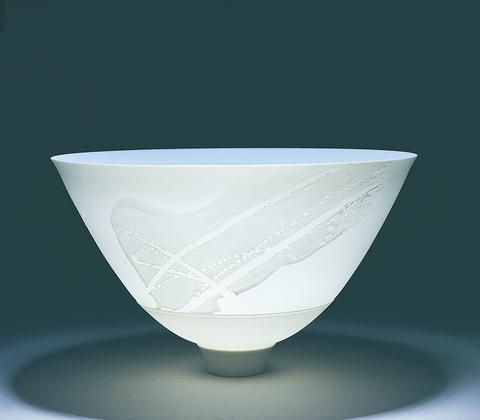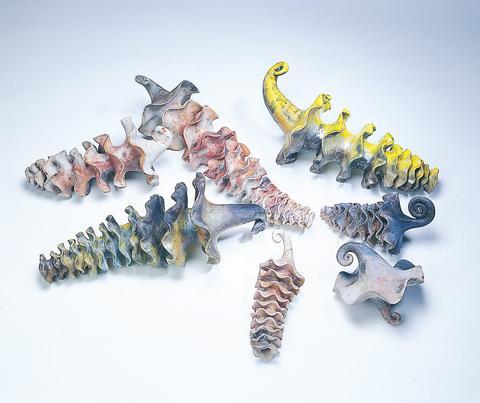Ceramic arts including pottery, stoneware and porcelains have for centuries been the stuff for which China has been celebrated globally. Exported porcelains were given the name China (from Cina in Roman times) to mean ceramics among Europeans.
Back when Mesopotamia and Egypt were firing low-temperature earthenware, the Chinese were firing in proto-porcelains of great density and high ping, having developed the art of kiln making and temperature control early on.

PHOTO COURTESY OF KAOHSIUNG MUSEUM OF FINE ARTS
Chinese potters experimented with lustrous and matt glazes, firing them under atmospheric and reduction kilns affecting the chemical composition of oxides in the glaze, resulting in heavenly jade-like celadons and the equally famous ox-blood reds. They were the first to use kaolin clay for porcelains, so that when thin enough, the walls revealed breathtaking translucency.

PHOTO COURTESY OF KAOHSIUNG MUSEUM OF FINE ARTS
Ceramics celebrate the most fundamental "Five Elements" of our habitat: a skillful and artistic integration of earth, water and fire, together with metal in the glazes and wood for the firing.
When temperatures rise to incandescence, a look through the peephole will show the clay (earth!) in the act of dissolving, of melting and bubbling or blistering in white heat. It is like witnessing creation itself. These elements bring us close to nature and impart a sense of the sacred, rarely experienced elsewhere.
Chinese potters have for millennia reflected sensitivity to working this malleable, yet enduring medium, striving for more shiny, more polished effects.
Japanese potters, on the other hand, have long preferred naturalness of materials and processes, and have evolved an ethos highlighting firing marks, pits, blisters and irregularities in the clay that may arise in firing, so that Japanese ware, often tactile and dramatic, honors raw materials.
The long pottery traditions of China, Korea and Japan make it appropriate for Taiwan to initiate an international gathering of potters, and indeed the Council for Cultural Affairs (行政院文化建設委員會) has launched Taiwan's first international ceramics biennale, organized by Taipei County Yingge Ceramics Museum (台北縣立鶯歌陶瓷博物館).
Experts have hired seven judges from Europe, America. Japan and Taiwan, who together identified from among nearly 700 submissions from around the world, the 125 winning pieces from 26 countries.
Hereafter huge disappointment sets in. The Grand Prize of NT$1.3 million, the highest ever to be awarded, went to Yoshikawa Masamichi (
Huge (140cm x 78cm) in scale but low slung (20cm in height), the glossy thin-walled compound includes compounds and a proverbial pigsty. Crafted in precision rectilinearity, it typifies Japanese architecture and, ironically, it's glazed in the swooning shimmer of celestial yingqing -- an iron-based reduction pale blue beloved for centuries in Japan.
The work's chief merit is the difficulty in handling kaolin on such a large scale without supports. But otherwise, no advance is evinced in either firing or glazing and worse, there is no feel for the materials in this borrowing of porcelain to imitate lacquered steel.
Second prize was also a massive (110cm x 78cm) ceramic imitation of "fictitious machinery" by American Steven Montgomery.
Again, the elemental ingredients that enliven this genre were denied participation. Once more the strength lay in surmounting technical difficulties when making metallic forms with unsuitable material -- but we miss the inspiration of art.
Effort centers on imitating a broken junk-yard car engine. If this is a current trend, then is it meritorious for artists or juries to follow trends? Whither independence or taste?
Third prize went to Swiss potter Arnold Annen whoseTranslucent Porcelain Bowl invites light to shine through thin walls (1mm to 1.5mm) revealing abstract designs in graduated thickness. This is the anhua technique perfected in Song Dynasty China a millennium back, and is here given a handsome modern look, white on white in a natural asymmetrical balance.
There are a few other works of high originality that extol the qualities and capabilities unique to earth-fired art -- aspects not possible for other media -- but alas, these have been far too few, and not honored.
Exhibition notes:
What: Taiwan's first international ceramics biennale
Where: Kaohsiung Museum of Fine Arts Galleries, 101-103, 80 Meishukuan Road, Kaohsiung (
When: Until Sept. 12, 9am to 5pm (closed Mondays).

On April 26, The Lancet published a letter from two doctors at Taichung-based China Medical University Hospital (CMUH) warning that “Taiwan’s Health Care System is on the Brink of Collapse.” The authors said that “Years of policy inaction and mismanagement of resources have led to the National Health Insurance system operating under unsustainable conditions.” The pushback was immediate. Errors in the paper were quickly identified and publicized, to discredit the authors (the hospital apologized). CNA reported that CMUH said the letter described Taiwan in 2021 as having 62 nurses per 10,000 people, when the correct number was 78 nurses per 10,000

As we live longer, our risk of cognitive impairment is increasing. How can we delay the onset of symptoms? Do we have to give up every indulgence or can small changes make a difference? We asked neurologists for tips on how to keep our brains healthy for life. TAKE CARE OF YOUR HEALTH “All of the sensible things that apply to bodily health apply to brain health,” says Suzanne O’Sullivan, a consultant in neurology at the National Hospital for Neurology and Neurosurgery in London, and the author of The Age of Diagnosis. “When you’re 20, you can get away with absolute

May 5 to May 11 What started out as friction between Taiwanese students at Taichung First High School and a Japanese head cook escalated dramatically over the first two weeks of May 1927. It began on April 30 when the cook’s wife knew that lotus starch used in that night’s dinner had rat feces in it, but failed to inform staff until the meal was already prepared. The students believed that her silence was intentional, and filed a complaint. The school’s Japanese administrators sided with the cook’s family, dismissing the students as troublemakers and clamping down on their freedoms — with

As Donald Trump’s executive order in March led to the shuttering of Voice of America (VOA) — the global broadcaster whose roots date back to the fight against Nazi propaganda — he quickly attracted support from figures not used to aligning themselves with any US administration. Trump had ordered the US Agency for Global Media, the federal agency that funds VOA and other groups promoting independent journalism overseas, to be “eliminated to the maximum extent consistent with applicable law.” The decision suddenly halted programming in 49 languages to more than 425 million people. In Moscow, Margarita Simonyan, the hardline editor-in-chief of the